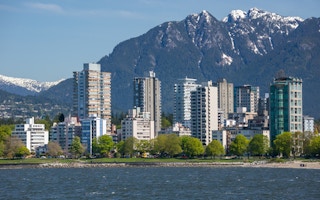The International Union of Architects has unanimously adopted a declaration committing to the phasing out of carbon dioxide emissions in the built environment by 2050, presented to it by Australian Institute of Architects chief executive David Parken.
The 2050 Imperative, which was presented last Friday at the UIA World Congress in Durban, recognises the urgency of the UIA and its member organisations in committing to a sustainable, equitable future.
“Urban areas are responsible for over 70 per cent of global energy consumption and CO2 emissions, mostly from buildings, and over the next two decades an area roughly equal to 60 per cent of the world’s total building stock is projected to be built and rebuilt in urban areas,” the declaration states.
“This provides an unprecedented opportunity to reduce fossil fuel CO2 emissions by setting the global building sector on a path to phase out CO2 emissions by 2050.
“Our responsibility is to influence ethical and socially responsible development throughout the world: to plan and design sustainable, resilient, carbon-neutral and healthy built environments that protect and enhance natural resources and wildlife habitats, provide clean air and water, generate on-site renewable energy, and advance more livable buildings and communities.”
The 2050 Imperative, commits member organisations to advocacy and promotion pertaining to planning and design of carbon neutral cities, towns, urban developments and new buildings; engaging in research and setting targets towards meeting the 2050 goal and developing and delivering equitable access to the information and tools to deliver these objectives.
The full Declaration 2050 Imperative:
Recalling the Chicago Declaration of Interdependence for a Sustainable Future (18-21 June 1993) which recognised our ecological interdependence with the whole natural environment and committing to place environmental and social sustainability at the core of our practice and professional responsibilities.
Also recognising the importance of the Post-2015 Development Agenda and the Sustainable Development Goals process to achieve a sustainable future; in particular, supporting a stand-alone goal to “make cities and human settlements inclusive, safe, resilient and sustainable”.
Recalling the United Nations Framework Convention on Climate Change (UNFCCC) conference that will reconvene in Paris in 2015 with the goal of reaching a new agreement on phasing out CO2 emissions from worldwide power and industrial sectors by 2050, and all GHG emissions from energy systems by the second half of the 21st century.
“
Our responsibility is to influence ethical and socially responsible development throughout the world: to plan and design sustainable, resilient, carbon-neutral and healthy built environments that protect and enhance natural resources and wildlife habitats, provide clean air and water, generate on-site renewable energy, and advance more livable buildings and communities
International Union of Architects
Recognising that urban areas are responsible for over 70 per cent of global energy consumption and CO2 emissions, mostly from buildings. Over the next two decades, an area roughly equal to 60 per cent of the total building stock of the world is projected to be built and rebuilt in urban areas worldwide. This provides an unprecedented opportunity to reduce fossil fuel CO2 emissions by setting the global building sector on a path to phase out CO2 emissions by 2050.
We recognise our responsibility to seize this unique opportunity to influence ethical and socially responsible development throughout the world: to plan and design sustainable, resilient, carbon-neutral and healthy built environments that protect and enhance natural resources and wildlife habitats, provide clean air and water, generate on-site renewable energy, and advance more liveable buildings and communities.
By adopting the 2050 IMPERATIVE at the International Union of Architects (UIA) World Congress in Durban, the UIA and its member organisations and partners will send a strong message to the Parties of the UNFCCC, and to the world, that we are committed to a truly sustainable and equitable future.
The UIA is acutely aware that failing to act now on climate change will put future generations and those already affected by extreme weather, natural disasters, and poverty, at great risk.
Recognising the architect’s central role in planning and designing the built environment, and the need to reduce carbon emissions to zero by 2050 and provide equal access to shelter, we commit to promote the following actions:
- Plan and design cities, towns, urban developments and new buildings to be carbon neutral, meaning they use no more energy over the course of a year than they produce, or import, from renewable energy sources.
- Renovate and rehabilitate existing cities, towns, urban redevelopments and buildings to be carbon neutral whilst respecting cultural and heritage values.
- In those cases where reaching carbon neutral is not feasible or practical, plan and design cities, towns, urban developments, new buildings and renovations to be highly efficient with the capability to produce, or import, all their energy from renewable energy sources in the future.
- We commit to the principle of engaging in research and setting targets towards meeting the 2050 goal.
- Advocate and promote socially responsible architecture for the community, develop and deliver equitable access to the information and tools needed to:
- plan and design sustainable, resilient, inclusive and low-carbon/zero carbon built environments
- design no-cost/low-cost on-site renewable energy and natural resources systems (e.g., passive heating and cooling, water catchment and storage, solar hot water, daylighting, and natural ventilation systems)
Signatories:
- UIA – International Union of Architects
- ARCASIA – Architects Regional Council Asia
- AUA – African Union of Architects
- ACE – Architects Council of Europe
- FPAA – Federacion Panamericana de Asociaciones de Arquitectos
- CAA – Commonwealth Association of Architects
- UMAR – Union Mediterraneenne des Architectes
- CA – Canberra Accord
- UIA Young Architects
- CIALP – Conselho Internacional dos Arquitectos de Lingua Portuguesa
- DoCoMoMo – Docomomo International
- FAU – Foundation des Architectes de I’Urgence
- AHA – Active House Alliance
- WGBC – World Green Building Council
- ICOMOS- International Council on Monuments and Sites








